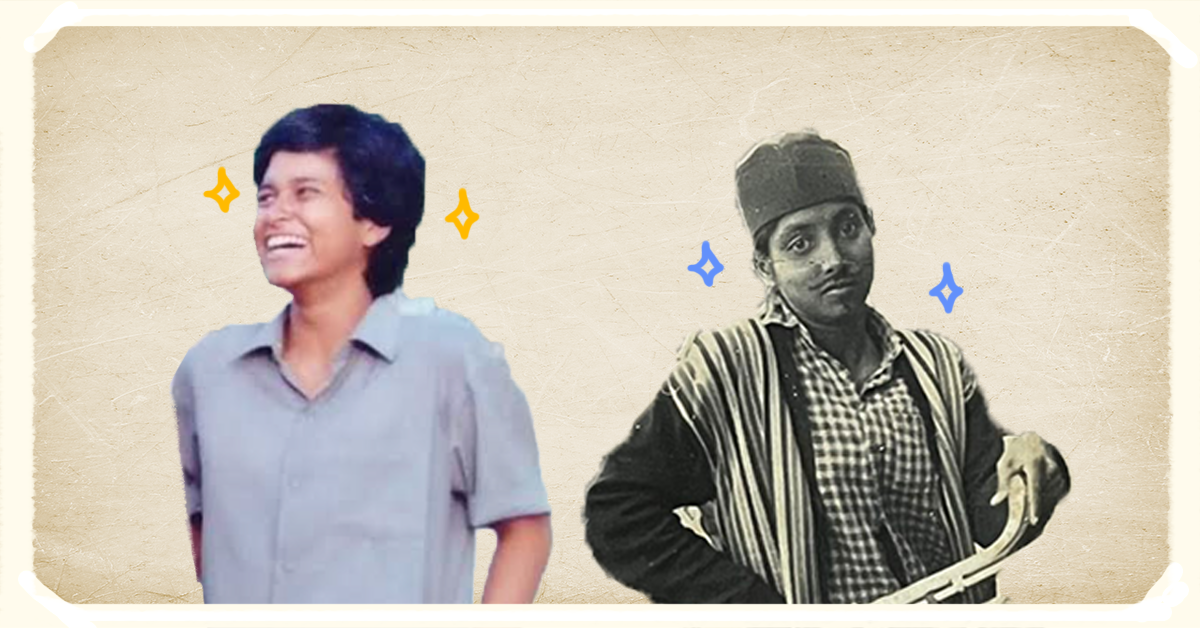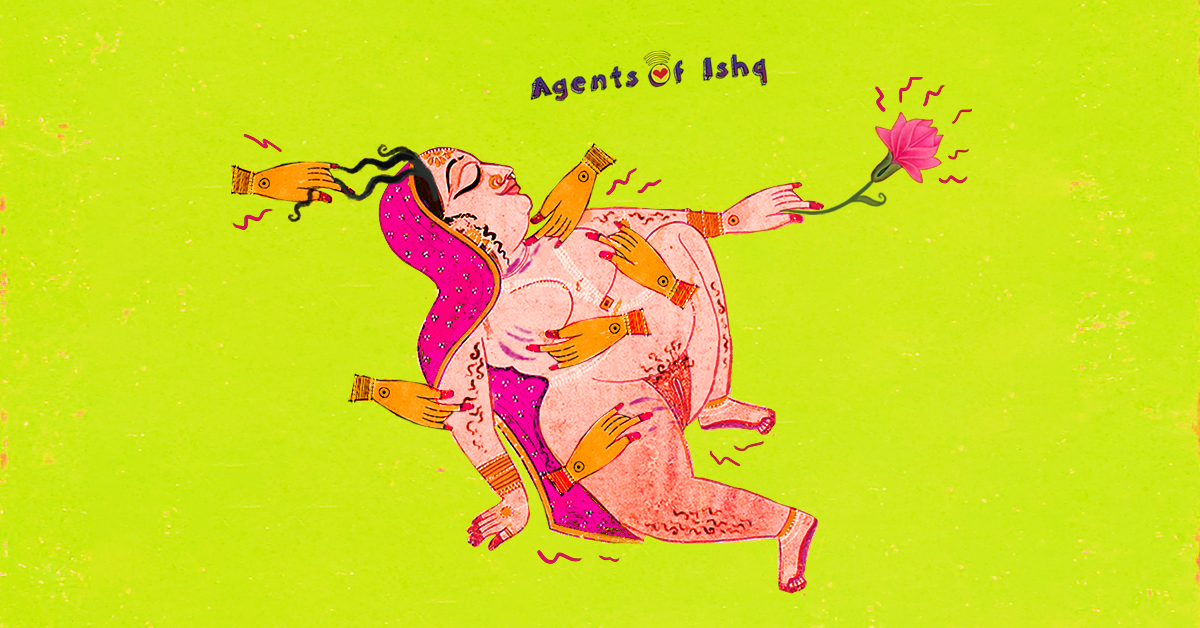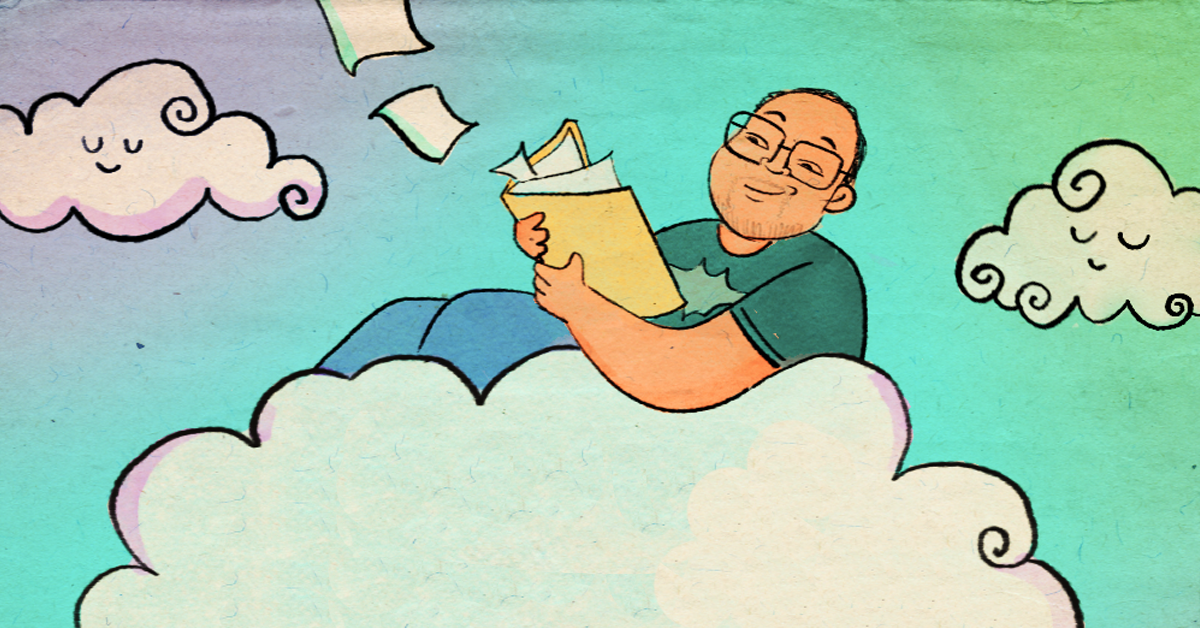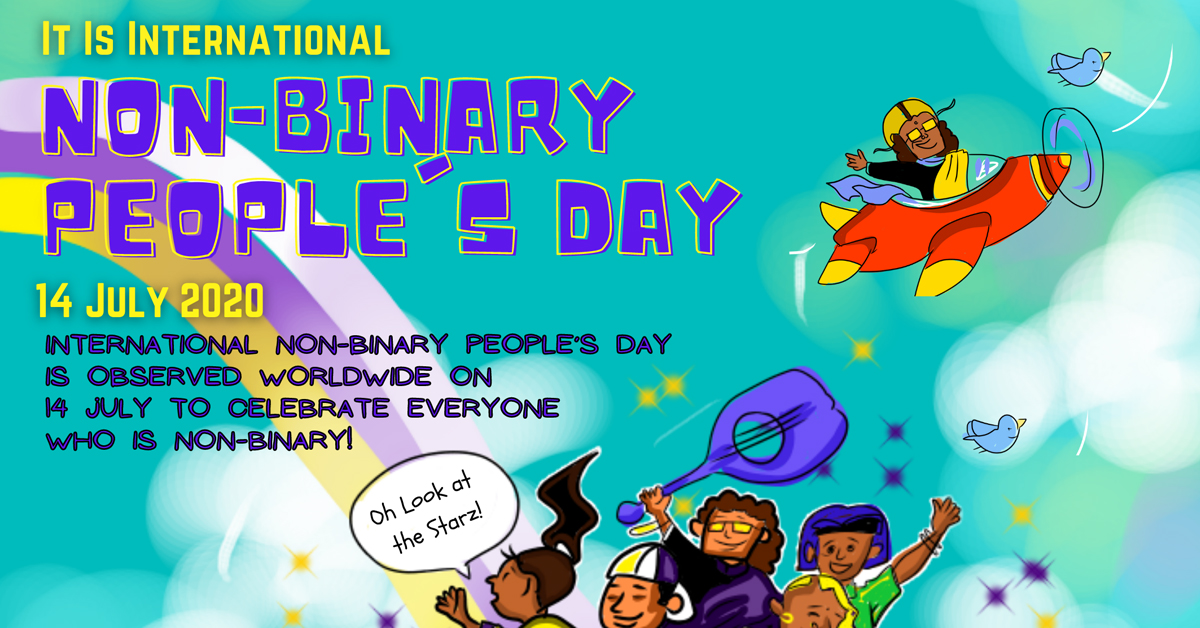What happens when women fall in love and lust with each other? Why don't we hear that many stories about this dilbari? Jee haan, AOI is magnifying the L in LGBTQ with this reading list, and all this month- stories of LBT loves and lesbian and lives across the Indian expanse. When we talk of queer love we see the narratives of men more prominently visible in public culture - but dhoondne se kya nahin milta? Here's a reading list of fiction, non-fiction, memoir, masala romance, essays and more, about women desiring women. Is there a work you know that's not on the list? Leave a comment so we can add it as we go, because love is and stories are, infinite - so lists can also aspire to be. 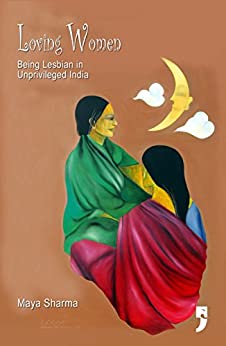 by Maya SharmaPublished in 2016“The narratives in this volume constitute immense challenges and small but profoundly significant triumphs. Located within a personal journey of emergence from a space fraught with silences and half-truths, the book documents the life-stories of ten working-class queer women living in north India. In doing so, it dispels the myth that lesbians in India are all urban, westernized and come from upper and middle classes.” But these real-life narratives do more than create a space for voices with little or no privilege; rather, they make vivid the lived loves of women, the urgency of romance, the flair of flirtation, the breathlessness of first meetings, the intensity of sex, the eroticism of secret meeting, the sharpness of heartbreak – all the things that make love love, and people people. Written to influence the women’s movement into a more fulsome inclusion of lesbian women in the movement, the book also dazzles us with the power of stories.
by Maya SharmaPublished in 2016“The narratives in this volume constitute immense challenges and small but profoundly significant triumphs. Located within a personal journey of emergence from a space fraught with silences and half-truths, the book documents the life-stories of ten working-class queer women living in north India. In doing so, it dispels the myth that lesbians in India are all urban, westernized and come from upper and middle classes.” But these real-life narratives do more than create a space for voices with little or no privilege; rather, they make vivid the lived loves of women, the urgency of romance, the flair of flirtation, the breathlessness of first meetings, the intensity of sex, the eroticism of secret meeting, the sharpness of heartbreak – all the things that make love love, and people people. Written to influence the women’s movement into a more fulsome inclusion of lesbian women in the movement, the book also dazzles us with the power of stories. 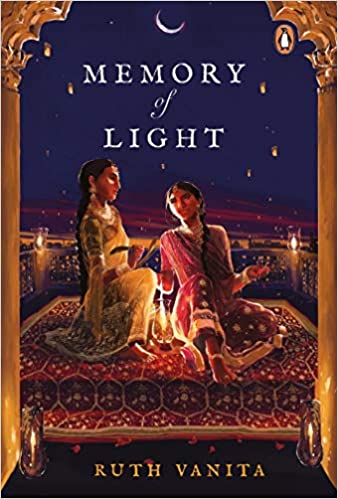 by Ruth VanitaPublished in 2020Set in 18th century Lucknow, this alluring love story is narrated by a poet, Nafis Bai, who falls passionately for Chapla Bai, a captivating courtesan of Kashi visiting Lucknow to perform at the fiftieth birthday gala of King George the Third. Trials and tribulation follow when Chapla Bai has to leave for home and their life-changing love becomes a long-distance relationship without the internet.As it follows their dil ka drama, the book draws a picture of a time and world where gender roles were more fluid, egalitarian friendships between genders thrived and romance was full of poetic excitement.
by Ruth VanitaPublished in 2020Set in 18th century Lucknow, this alluring love story is narrated by a poet, Nafis Bai, who falls passionately for Chapla Bai, a captivating courtesan of Kashi visiting Lucknow to perform at the fiftieth birthday gala of King George the Third. Trials and tribulation follow when Chapla Bai has to leave for home and their life-changing love becomes a long-distance relationship without the internet.As it follows their dil ka drama, the book draws a picture of a time and world where gender roles were more fluid, egalitarian friendships between genders thrived and romance was full of poetic excitement. 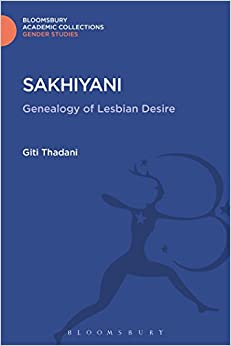 By Giti ThadaniPublished in 1996A landmark for being one of the first accounts of lesbian existence in contemporary India. The book provies historical perspectives that shaped contemporary attitudes to lesbian existence – such as outlandish colonial views of lesbian women as soft victims or sexually dangerous women with ‘overgrown clitoris’ who needed to be domesticated.
By Giti ThadaniPublished in 1996A landmark for being one of the first accounts of lesbian existence in contemporary India. The book provies historical perspectives that shaped contemporary attitudes to lesbian existence – such as outlandish colonial views of lesbian women as soft victims or sexually dangerous women with ‘overgrown clitoris’ who needed to be domesticated.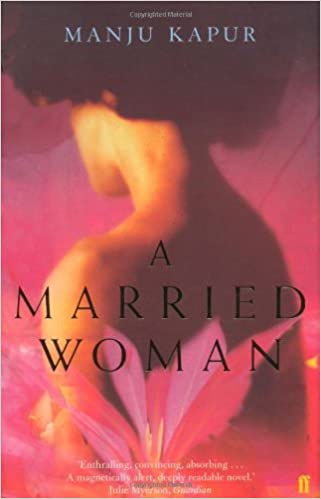 By Manju KapurPublished in 2002Set in 1970’s Delhi, the story follows the life of Aastha, an obedient yet dreamy girl brought up in a middle-class family who first half-heartedly, later comfortably, settles into an arranged marriage. After a few years of loving her married life with children, she embraces her inclination to arts and theatre which lead her to Pippee, the widow of her theatre colleague. When she gives in to the shy but erotic energy she feels with Pippee, she realises that the connection is not only erotic, but that she’s found someone who truly wants to know her, rather than to own her.
By Manju KapurPublished in 2002Set in 1970’s Delhi, the story follows the life of Aastha, an obedient yet dreamy girl brought up in a middle-class family who first half-heartedly, later comfortably, settles into an arranged marriage. After a few years of loving her married life with children, she embraces her inclination to arts and theatre which lead her to Pippee, the widow of her theatre colleague. When she gives in to the shy but erotic energy she feels with Pippee, she realises that the connection is not only erotic, but that she’s found someone who truly wants to know her, rather than to own her.  by Kamala DasPublished in 1988The novella Chandana Marangal, Malayalam for “Sandal Trees”, follows the relationship between Sheela, a girl from a well-off family, and Kalyanikutty, a girl from a poor family, who fall in love as teenagers. When their families find out, they try to marry them off to men, and on Sheela’s wedding day, Kalyani suggests running away. (Do they? Aha! We’re not going to tell you so easily!) We see the two women as they study medicine and grow older, contemplating their love and the social structures that try to prise them apart.But okay, we’ll tell you this much: this story has powerful, sensual descriptions of lesbian desire (it is a story by Kamal Das, after all, who caused something of an earthquake in Kerala in the 1970s, when her autobiography Enthe Katha, with its description of sexuality and same-sex love, came out). And here’s a clue about the title: the sandal trees that the story refers to are connected to Kalyani, who is described as having skin the colour of sandalwood.
by Kamala DasPublished in 1988The novella Chandana Marangal, Malayalam for “Sandal Trees”, follows the relationship between Sheela, a girl from a well-off family, and Kalyanikutty, a girl from a poor family, who fall in love as teenagers. When their families find out, they try to marry them off to men, and on Sheela’s wedding day, Kalyani suggests running away. (Do they? Aha! We’re not going to tell you so easily!) We see the two women as they study medicine and grow older, contemplating their love and the social structures that try to prise them apart.But okay, we’ll tell you this much: this story has powerful, sensual descriptions of lesbian desire (it is a story by Kamal Das, after all, who caused something of an earthquake in Kerala in the 1970s, when her autobiography Enthe Katha, with its description of sexuality and same-sex love, came out). And here’s a clue about the title: the sandal trees that the story refers to are connected to Kalyani, who is described as having skin the colour of sandalwood.  By Ashwini SukthankarPublished in 1999A collection of fiction, poetry, personal essays and histories, the book delves into lost and found, distorted yet mesmerising, razed and risen, diverse, complex, rich, true-life stories of lesbian love and desire from across India. It was the first of a kind anthology that presented a picture of women loving women in all their mess, rage, despair, perversion, and connivance. It made visible an otherwise hidden reality.
By Ashwini SukthankarPublished in 1999A collection of fiction, poetry, personal essays and histories, the book delves into lost and found, distorted yet mesmerising, razed and risen, diverse, complex, rich, true-life stories of lesbian love and desire from across India. It was the first of a kind anthology that presented a picture of women loving women in all their mess, rage, despair, perversion, and connivance. It made visible an otherwise hidden reality. 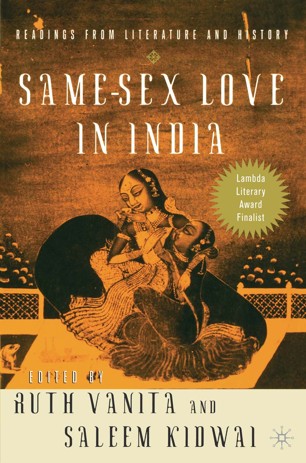 By Ruth Vanita And Saleem KidwaiPublished in 2001An anthology of writings about same-sex love from over 2000 years of Indian literature. Translated from many languages of the Indian subcontinent, these writings solidify evidence of same-sex love having been richly and significantly present in Indian history. Ample examples of lesbian relationships throughout pre-colonial periods acknowledge that Indian societies were not so rigid and villanizing of same-sex romances and friendships, a preudice that’s a byproduct of imperialist rule.
By Ruth Vanita And Saleem KidwaiPublished in 2001An anthology of writings about same-sex love from over 2000 years of Indian literature. Translated from many languages of the Indian subcontinent, these writings solidify evidence of same-sex love having been richly and significantly present in Indian history. Ample examples of lesbian relationships throughout pre-colonial periods acknowledge that Indian societies were not so rigid and villanizing of same-sex romances and friendships, a preudice that’s a byproduct of imperialist rule. 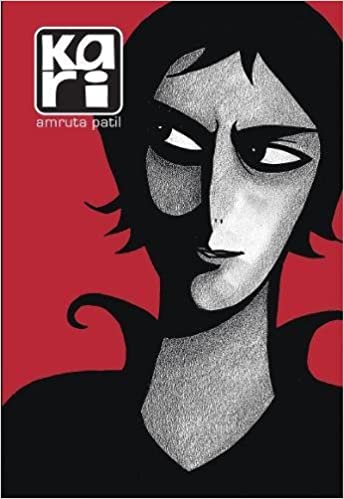 By Amruta PatilPublished in 2008In the beginning Kari and her lover Ruth try to kill themselves by jumping from the top of a building. Ruth is saved by a safety net and runs away abroad. Kari falls into a sewer and goes on to live in the smog city of Bombay. Then this marvelous graphic novel goes on to tell the story of Kari, her friends, the secrets of her heart and the secrets of the city. Patil’s beautiful art is only matched by the lushness of her prose.
By Amruta PatilPublished in 2008In the beginning Kari and her lover Ruth try to kill themselves by jumping from the top of a building. Ruth is saved by a safety net and runs away abroad. Kari falls into a sewer and goes on to live in the smog city of Bombay. Then this marvelous graphic novel goes on to tell the story of Kari, her friends, the secrets of her heart and the secrets of the city. Patil’s beautiful art is only matched by the lushness of her prose.  By Ismat Chughtai Published in 1945This novel deals with the lives of middle-class Muslim women using everyday language, a style that Salim Kidwai points out was not used in Urdu prose before Chughtai. Kidwai also writes that this is “the first important Urdu novel on Muslim women; it shows sex as an instrument both of women's oppression and of their rebellion.”We see two generations of women in the novel – the older one consists of women in purdah, whose choices and exposure to the world are limited. The younger women, Shamman (the protagonist) and her friends, lead lives less cloistered, but in a country heading towards independence, freedom isn’t quite theirs yet. What all the women do have, though, are their relationships with each other. In the novel’s description of Shamman’s childhood, in which anyone who went to an all-girls’ school might recognise their own little horny selves and fellow students, we see Shamman infatuated with her teacher, Miss Charan, and fantasise about the older woman, just as we see Shamman become the object of desire for other girls her age.
By Ismat Chughtai Published in 1945This novel deals with the lives of middle-class Muslim women using everyday language, a style that Salim Kidwai points out was not used in Urdu prose before Chughtai. Kidwai also writes that this is “the first important Urdu novel on Muslim women; it shows sex as an instrument both of women's oppression and of their rebellion.”We see two generations of women in the novel – the older one consists of women in purdah, whose choices and exposure to the world are limited. The younger women, Shamman (the protagonist) and her friends, lead lives less cloistered, but in a country heading towards independence, freedom isn’t quite theirs yet. What all the women do have, though, are their relationships with each other. In the novel’s description of Shamman’s childhood, in which anyone who went to an all-girls’ school might recognise their own little horny selves and fellow students, we see Shamman infatuated with her teacher, Miss Charan, and fantasise about the older woman, just as we see Shamman become the object of desire for other girls her age. Edited by Minal HajratwalaPublished in 2012A Sikh mother talks about her son becoming her daughter. A young gay man talks about Section 377 with fellow law students in Bangalore even as the Delhi High Court is making a decision. Two female were-lions with henna tattoos fall in love. So do boarding schoolgirls. Two small-town girls fall in love, make plans but sort of miss the bus. A woman embraces her dead husband’s gay lover. This collection of 30 stories (some translated) tells an ambitious range of queer narratives – several of them featuring women who love women. The Dead Camel & Other Stories of Love
Edited by Minal HajratwalaPublished in 2012A Sikh mother talks about her son becoming her daughter. A young gay man talks about Section 377 with fellow law students in Bangalore even as the Delhi High Court is making a decision. Two female were-lions with henna tattoos fall in love. So do boarding schoolgirls. Two small-town girls fall in love, make plans but sort of miss the bus. A woman embraces her dead husband’s gay lover. This collection of 30 stories (some translated) tells an ambitious range of queer narratives – several of them featuring women who love women. The Dead Camel & Other Stories of Love 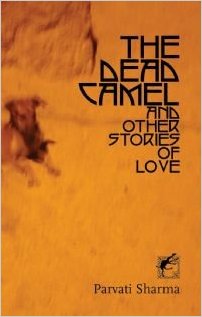 by Parvati Sharma Published in 2010Sharma’s collection of perfect short stories deserves every bit of fervent admiration it received and more. From the story of the man who has a fetish for making beds to the sparkling reinterpretation of Ismat Chugtai’s Lihaaf, from the housewife fed up with the sounds of sex next door to the novelist who almost kills a prospective publisher, every story in this debut collection has play, pleasure and kindness.
by Parvati Sharma Published in 2010Sharma’s collection of perfect short stories deserves every bit of fervent admiration it received and more. From the story of the man who has a fetish for making beds to the sparkling reinterpretation of Ismat Chugtai’s Lihaaf, from the housewife fed up with the sounds of sex next door to the novelist who almost kills a prospective publisher, every story in this debut collection has play, pleasure and kindness.  By Kavya Kadame Nagarakatte Published in 2017In her first novel, award-winning young Kannada poet Kavya Kadame tells the story of Asma and Anusha who come from very different backgrounds and find themselves madly attracted to each other. Kadame has said that the idea for her novel grew out of reading Mohanaswamy and Julian Barnes’ Sense of An Ending. Punarapi has been admired for its beautiful prose and earnest young heroines.
By Kavya Kadame Nagarakatte Published in 2017In her first novel, award-winning young Kannada poet Kavya Kadame tells the story of Asma and Anusha who come from very different backgrounds and find themselves madly attracted to each other. Kadame has said that the idea for her novel grew out of reading Mohanaswamy and Julian Barnes’ Sense of An Ending. Punarapi has been admired for its beautiful prose and earnest young heroines. 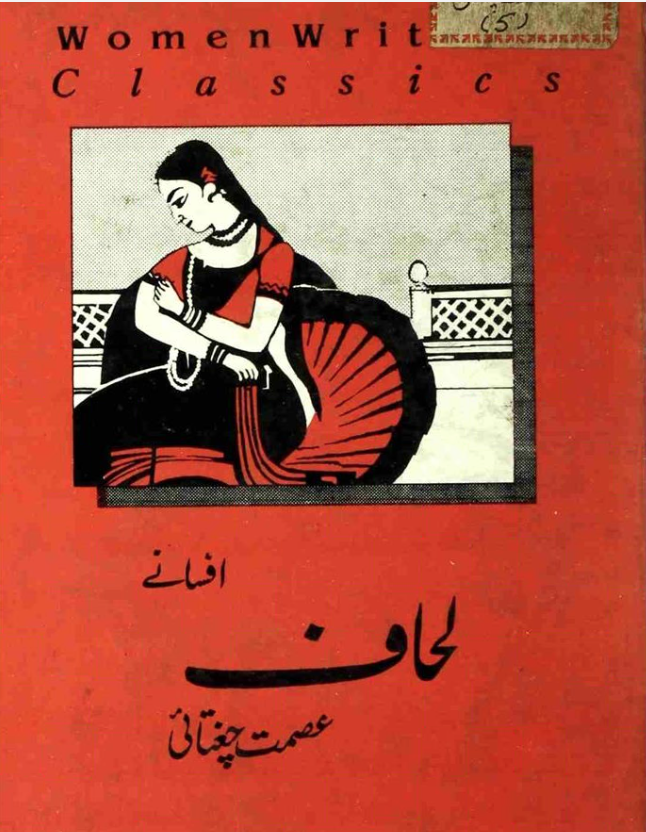 By Ismat ChughtaiPublished in 1945It all begins with Begum Jaan moaning,
By Ismat ChughtaiPublished in 1945It all begins with Begum Jaan moaning,  A short story, which got the author in tons of trouble, and an obscenity trial at the Lahore court in the 1940s, it isn’t explicitly sexual — it has more to do with the sensual power of touch. Lihaaf is about a young girl, who is in awe of and head over heels about a formidable woman named Begum Jaan. Begum Jaan has had a miserable life after marriage because her husband is gay and can’t satisfy her sexually. She gets her masseuse Rabbu to rub and bathe and scratch her body all through the day, and on cold nights. One day when Rabbu is otherwise occupied, the young girl massages Begum Jaan instead and discovers a waterfall of feelings that she didn’t know existed. Close, Too Close Tranquebar Book of Queer Erotica
A short story, which got the author in tons of trouble, and an obscenity trial at the Lahore court in the 1940s, it isn’t explicitly sexual — it has more to do with the sensual power of touch. Lihaaf is about a young girl, who is in awe of and head over heels about a formidable woman named Begum Jaan. Begum Jaan has had a miserable life after marriage because her husband is gay and can’t satisfy her sexually. She gets her masseuse Rabbu to rub and bathe and scratch her body all through the day, and on cold nights. One day when Rabbu is otherwise occupied, the young girl massages Begum Jaan instead and discovers a waterfall of feelings that she didn’t know existed. Close, Too Close Tranquebar Book of Queer Erotica 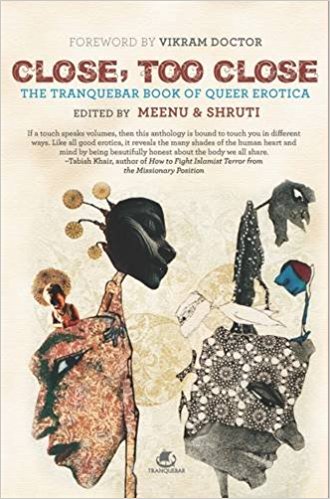 Edited by Meenu and ShrutiPublished in 2012This volume is a clear example of how versatile and inclusive erotic writing can be, and how erotic writing can be used to invoke a whole bunch of feelings, beyond just plain arousal. From stories about two women who see each other underwater and then shower together, to a mythological story about two men who disguise themselves as newlyweds to be later tricked by the gods, to one about transmen wordlessly negotiating the limits of each others’ bodies (in a story that also touches upon necrophilia — hey, different strokes for different folks), to one that eroticises groping on a bus, the volume covers a variety of tones designed to evoke feelings as varied as arousal, heart-sickness, cringe and even a little bit of creepiness.
Edited by Meenu and ShrutiPublished in 2012This volume is a clear example of how versatile and inclusive erotic writing can be, and how erotic writing can be used to invoke a whole bunch of feelings, beyond just plain arousal. From stories about two women who see each other underwater and then shower together, to a mythological story about two men who disguise themselves as newlyweds to be later tricked by the gods, to one about transmen wordlessly negotiating the limits of each others’ bodies (in a story that also touches upon necrophilia — hey, different strokes for different folks), to one that eroticises groping on a bus, the volume covers a variety of tones designed to evoke feelings as varied as arousal, heart-sickness, cringe and even a little bit of creepiness.  By VT NandakumarPublished in 1974VT Nandakumar’s Malayalam novel “Two Girls” first appeared in serialised form in Chitrakarthika Weekly. The novel traces the relationship between Girija, a schoolgirl who wants to be strong like the boy next door and kiss a beautiful girl, and who falls hard for Kokila, the gorgeous new student at her school. In his introduction to the second edition of the novel, Nandakumar makes an unusual plea: “Lesbianism – which means a love affair between women – is now ubiquitous. In my opinion this passion is likely to be widespread among the young women of Kerala who, by nature, are extraordinarily sensitive. Such relationships have some healthy and positive potential hence they are important. […] Let me conclude by praying for the growth and prosperity of lesbianism.”
By VT NandakumarPublished in 1974VT Nandakumar’s Malayalam novel “Two Girls” first appeared in serialised form in Chitrakarthika Weekly. The novel traces the relationship between Girija, a schoolgirl who wants to be strong like the boy next door and kiss a beautiful girl, and who falls hard for Kokila, the gorgeous new student at her school. In his introduction to the second edition of the novel, Nandakumar makes an unusual plea: “Lesbianism – which means a love affair between women – is now ubiquitous. In my opinion this passion is likely to be widespread among the young women of Kerala who, by nature, are extraordinarily sensitive. Such relationships have some healthy and positive potential hence they are important. […] Let me conclude by praying for the growth and prosperity of lesbianism.” 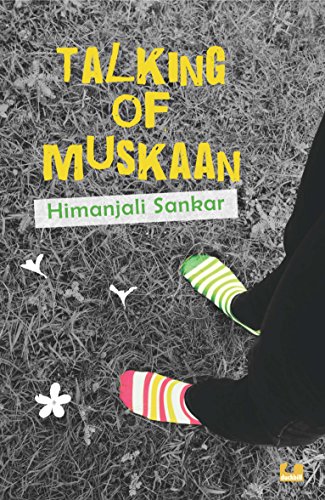 By Himanjali Sarkar Published in 2014“Muskaan hadn’t come to school.All of them were secretly relieved.”That’s how this novel about a schoolgirl begins, and her friends’ relief turns to horror as they learn that she is in the ICU after trying to take her life.What is it like when you don’t fit in, and you feel like you’re on the outside watching while everyone else is having a party without you? In this story, told by Muskaan’s friends, we piece together what was at the heart of Muskaan’s despair and dive right into the world of teenagers. It isn’t just the fact that Muskaan likes girls that sends a ripple through their world: all of the young people in this story have some reckoning to do – and while they learn to accept Muskaan for who she is, they have to figure out who they are too.
By Himanjali Sarkar Published in 2014“Muskaan hadn’t come to school.All of them were secretly relieved.”That’s how this novel about a schoolgirl begins, and her friends’ relief turns to horror as they learn that she is in the ICU after trying to take her life.What is it like when you don’t fit in, and you feel like you’re on the outside watching while everyone else is having a party without you? In this story, told by Muskaan’s friends, we piece together what was at the heart of Muskaan’s despair and dive right into the world of teenagers. It isn’t just the fact that Muskaan likes girls that sends a ripple through their world: all of the young people in this story have some reckoning to do – and while they learn to accept Muskaan for who she is, they have to figure out who they are too. 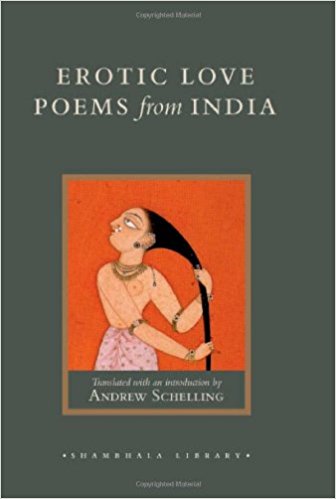 Translated by Andrew SchellingPublished in 2014Amaru was a mystic who wrote around 800 AD. He wrote delicious love poems in Sanskrit, about both homosexual and heterosexual love. Sometimes, his poems talk delightfully of love between women, sometimes they sound outraged at sub-standard hetero loving-
Translated by Andrew SchellingPublished in 2014Amaru was a mystic who wrote around 800 AD. He wrote delicious love poems in Sanskrit, about both homosexual and heterosexual love. Sometimes, his poems talk delightfully of love between women, sometimes they sound outraged at sub-standard hetero loving- The poems are passionate yet playful, and uniquely evocative in their narrative. The fact that they involve the kind of conversation you’d imagine taking place aloud and in people’s minds while having sex paints a particularly vivid picture, like this poem about two women making love-
The poems are passionate yet playful, and uniquely evocative in their narrative. The fact that they involve the kind of conversation you’d imagine taking place aloud and in people’s minds while having sex paints a particularly vivid picture, like this poem about two women making love-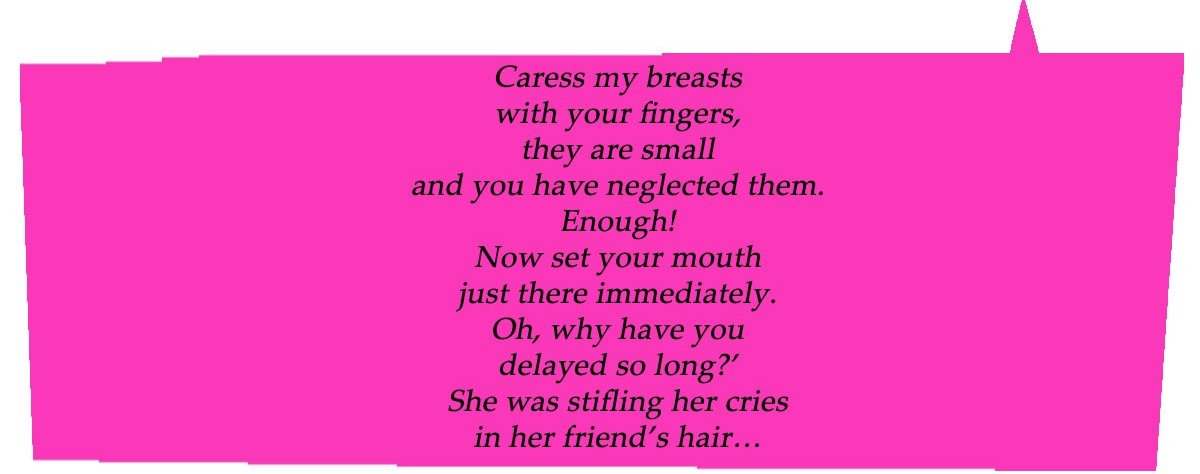
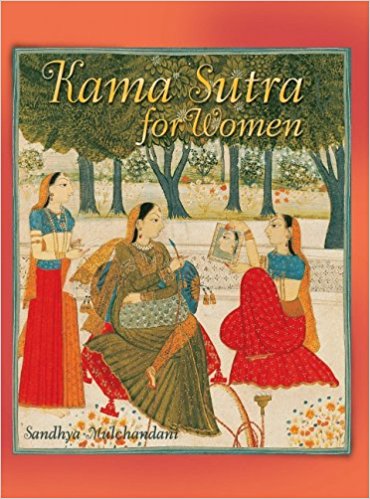 Translated and edited by Sandhya Mulchandani (Originally Sanskrit)Published in 2006This is a vital translation of the familiar book and the first to glean Mr Vatsayana for sexual advice exclusively for women. As the author says, “The most important lesson that this book has for modern society is that anything worth doing - and yes, this includes making love - is worth doing well and that happiness is not restricted to any one gender.” One reviewer described this marvelous handbook thus: “For those who can't be bothered with the theory, there is plenty of practical advice. For instance, even if you don't attempt all the 64 positions, it helps to keep your toes clean and sweet smelling.” Because, after all, the infamous sexual positions were only one out of 7 chapters in the Kama Sutra. The rest was about living the good life. This book emphasizes ways to keep interest in sex electric while worried by things like electricity bills. Unruly Figures: Queerness, Sex Work, and the Politics of Sexuality in Kerala
Translated and edited by Sandhya Mulchandani (Originally Sanskrit)Published in 2006This is a vital translation of the familiar book and the first to glean Mr Vatsayana for sexual advice exclusively for women. As the author says, “The most important lesson that this book has for modern society is that anything worth doing - and yes, this includes making love - is worth doing well and that happiness is not restricted to any one gender.” One reviewer described this marvelous handbook thus: “For those who can't be bothered with the theory, there is plenty of practical advice. For instance, even if you don't attempt all the 64 positions, it helps to keep your toes clean and sweet smelling.” Because, after all, the infamous sexual positions were only one out of 7 chapters in the Kama Sutra. The rest was about living the good life. This book emphasizes ways to keep interest in sex electric while worried by things like electricity bills. Unruly Figures: Queerness, Sex Work, and the Politics of Sexuality in Kerala By Navaneetha MokkilPublished by University of Washington Press in 2019In Kerala, homeground to the ‘Kiss of Love’ campaign and rife with political protests and events of resistance, the question of sexual identities and rights take on a layered significance. This book examines images of sex workers and lesbian sexuality across Malayalam films, literature, public spaces, popular media and conversations. By looking at films like The Wandering Bird Never Cries - about two young women who run away together - and Sancharram, as well as, projects like the autobiography of sex worker and activist Nalini Jameela, and Sweet Maria Monument (the memorialization of murdered transgender activist) in the context of post 1990 globalization, the book dynamises Indian debates on queerness. Living Life as a Queer Person: Role of Intimate Relationships in Consolidation of Identity
By Navaneetha MokkilPublished by University of Washington Press in 2019In Kerala, homeground to the ‘Kiss of Love’ campaign and rife with political protests and events of resistance, the question of sexual identities and rights take on a layered significance. This book examines images of sex workers and lesbian sexuality across Malayalam films, literature, public spaces, popular media and conversations. By looking at films like The Wandering Bird Never Cries - about two young women who run away together - and Sancharram, as well as, projects like the autobiography of sex worker and activist Nalini Jameela, and Sweet Maria Monument (the memorialization of murdered transgender activist) in the context of post 1990 globalization, the book dynamises Indian debates on queerness. Living Life as a Queer Person: Role of Intimate Relationships in Consolidation of Identity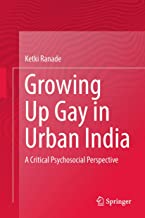 By Ketki RanadePublished in 2018Through experiential interviews with various lesbian and gay participants, the writer traces how individual queer identities deepen, and the way life’s challenging events and factors are exacerbated when they enter intimate same-sex relationships of any kind. The paper looks at questions of marriage, violence, and some issues unique to homosexual love in a time post dating apps and a visible gay rights movement, with an emotional directness.
By Ketki RanadePublished in 2018Through experiential interviews with various lesbian and gay participants, the writer traces how individual queer identities deepen, and the way life’s challenging events and factors are exacerbated when they enter intimate same-sex relationships of any kind. The paper looks at questions of marriage, violence, and some issues unique to homosexual love in a time post dating apps and a visible gay rights movement, with an emotional directness.
Loving Women: Being Lesbian in Unprivileged India
 by Maya SharmaPublished in 2016“The narratives in this volume constitute immense challenges and small but profoundly significant triumphs. Located within a personal journey of emergence from a space fraught with silences and half-truths, the book documents the life-stories of ten working-class queer women living in north India. In doing so, it dispels the myth that lesbians in India are all urban, westernized and come from upper and middle classes.” But these real-life narratives do more than create a space for voices with little or no privilege; rather, they make vivid the lived loves of women, the urgency of romance, the flair of flirtation, the breathlessness of first meetings, the intensity of sex, the eroticism of secret meeting, the sharpness of heartbreak – all the things that make love love, and people people. Written to influence the women’s movement into a more fulsome inclusion of lesbian women in the movement, the book also dazzles us with the power of stories.
by Maya SharmaPublished in 2016“The narratives in this volume constitute immense challenges and small but profoundly significant triumphs. Located within a personal journey of emergence from a space fraught with silences and half-truths, the book documents the life-stories of ten working-class queer women living in north India. In doing so, it dispels the myth that lesbians in India are all urban, westernized and come from upper and middle classes.” But these real-life narratives do more than create a space for voices with little or no privilege; rather, they make vivid the lived loves of women, the urgency of romance, the flair of flirtation, the breathlessness of first meetings, the intensity of sex, the eroticism of secret meeting, the sharpness of heartbreak – all the things that make love love, and people people. Written to influence the women’s movement into a more fulsome inclusion of lesbian women in the movement, the book also dazzles us with the power of stories. Memory of Light
 by Ruth VanitaPublished in 2020Set in 18th century Lucknow, this alluring love story is narrated by a poet, Nafis Bai, who falls passionately for Chapla Bai, a captivating courtesan of Kashi visiting Lucknow to perform at the fiftieth birthday gala of King George the Third. Trials and tribulation follow when Chapla Bai has to leave for home and their life-changing love becomes a long-distance relationship without the internet.As it follows their dil ka drama, the book draws a picture of a time and world where gender roles were more fluid, egalitarian friendships between genders thrived and romance was full of poetic excitement.
by Ruth VanitaPublished in 2020Set in 18th century Lucknow, this alluring love story is narrated by a poet, Nafis Bai, who falls passionately for Chapla Bai, a captivating courtesan of Kashi visiting Lucknow to perform at the fiftieth birthday gala of King George the Third. Trials and tribulation follow when Chapla Bai has to leave for home and their life-changing love becomes a long-distance relationship without the internet.As it follows their dil ka drama, the book draws a picture of a time and world where gender roles were more fluid, egalitarian friendships between genders thrived and romance was full of poetic excitement. Sakhiyani- Lesbian Desire in Ancient and Modern India
 By Giti ThadaniPublished in 1996A landmark for being one of the first accounts of lesbian existence in contemporary India. The book provies historical perspectives that shaped contemporary attitudes to lesbian existence – such as outlandish colonial views of lesbian women as soft victims or sexually dangerous women with ‘overgrown clitoris’ who needed to be domesticated.
By Giti ThadaniPublished in 1996A landmark for being one of the first accounts of lesbian existence in contemporary India. The book provies historical perspectives that shaped contemporary attitudes to lesbian existence – such as outlandish colonial views of lesbian women as soft victims or sexually dangerous women with ‘overgrown clitoris’ who needed to be domesticated.The first few chapters are quite densely academic as the book explores the fabric of female bonding, sexual and non-sexual, through a close study of art, mythology, cosmology, and Sanskrit texts of ancient India. The second half charts a lived history of lesbian desire and its contemporay contexts - marriages, suicide pacts, human rights, sexual exile, lesbophobia, family, and new ways of forming bonds and alliances. Its extensive research shone a light on the sometimes painful, sometimes vital and creative world of women who love women, in India.
A Married Woman
 By Manju KapurPublished in 2002Set in 1970’s Delhi, the story follows the life of Aastha, an obedient yet dreamy girl brought up in a middle-class family who first half-heartedly, later comfortably, settles into an arranged marriage. After a few years of loving her married life with children, she embraces her inclination to arts and theatre which lead her to Pippee, the widow of her theatre colleague. When she gives in to the shy but erotic energy she feels with Pippee, she realises that the connection is not only erotic, but that she’s found someone who truly wants to know her, rather than to own her.
By Manju KapurPublished in 2002Set in 1970’s Delhi, the story follows the life of Aastha, an obedient yet dreamy girl brought up in a middle-class family who first half-heartedly, later comfortably, settles into an arranged marriage. After a few years of loving her married life with children, she embraces her inclination to arts and theatre which lead her to Pippee, the widow of her theatre colleague. When she gives in to the shy but erotic energy she feels with Pippee, she realises that the connection is not only erotic, but that she’s found someone who truly wants to know her, rather than to own her. Chandana Marangal – Malayalam
 by Kamala DasPublished in 1988The novella Chandana Marangal, Malayalam for “Sandal Trees”, follows the relationship between Sheela, a girl from a well-off family, and Kalyanikutty, a girl from a poor family, who fall in love as teenagers. When their families find out, they try to marry them off to men, and on Sheela’s wedding day, Kalyani suggests running away. (Do they? Aha! We’re not going to tell you so easily!) We see the two women as they study medicine and grow older, contemplating their love and the social structures that try to prise them apart.But okay, we’ll tell you this much: this story has powerful, sensual descriptions of lesbian desire (it is a story by Kamal Das, after all, who caused something of an earthquake in Kerala in the 1970s, when her autobiography Enthe Katha, with its description of sexuality and same-sex love, came out). And here’s a clue about the title: the sandal trees that the story refers to are connected to Kalyani, who is described as having skin the colour of sandalwood.
by Kamala DasPublished in 1988The novella Chandana Marangal, Malayalam for “Sandal Trees”, follows the relationship between Sheela, a girl from a well-off family, and Kalyanikutty, a girl from a poor family, who fall in love as teenagers. When their families find out, they try to marry them off to men, and on Sheela’s wedding day, Kalyani suggests running away. (Do they? Aha! We’re not going to tell you so easily!) We see the two women as they study medicine and grow older, contemplating their love and the social structures that try to prise them apart.But okay, we’ll tell you this much: this story has powerful, sensual descriptions of lesbian desire (it is a story by Kamal Das, after all, who caused something of an earthquake in Kerala in the 1970s, when her autobiography Enthe Katha, with its description of sexuality and same-sex love, came out). And here’s a clue about the title: the sandal trees that the story refers to are connected to Kalyani, who is described as having skin the colour of sandalwood. More Than An Identity: How I Realised My Struggle Was With Being Sexual, Not Homosexual
By Debasmita Das‘... when you’re queer, your story always begins from the moment you knew you were gay’ are the words Debasmita’s shining personal essay begins with. With painstaking honesty, she traces her private, honest, inner-most confusions that remain submerged under the clear voice and cool cred of being a political queer person. As she reaches for a way to express her need for love, she also questions, whether a political language of identity is enough to span the complex weave of emotional, intellectual, social and political aspects that make up a life.Facing the Mirror: Lesbian Writing from India
 By Ashwini SukthankarPublished in 1999A collection of fiction, poetry, personal essays and histories, the book delves into lost and found, distorted yet mesmerising, razed and risen, diverse, complex, rich, true-life stories of lesbian love and desire from across India. It was the first of a kind anthology that presented a picture of women loving women in all their mess, rage, despair, perversion, and connivance. It made visible an otherwise hidden reality.
By Ashwini SukthankarPublished in 1999A collection of fiction, poetry, personal essays and histories, the book delves into lost and found, distorted yet mesmerising, razed and risen, diverse, complex, rich, true-life stories of lesbian love and desire from across India. It was the first of a kind anthology that presented a picture of women loving women in all their mess, rage, despair, perversion, and connivance. It made visible an otherwise hidden reality. Every Navratri Falguni Made Me Feel That Queer Is Ekdum Cool
By Sonal GianiThe story of admiration and adoration of the queer crush who made you realise how cool and charming your own queerness is, makes for an exemplary romance, song and dance music video included. In a refreshing and highly popular essay, Giani celebrates how the dandiya sensation Falguni Pathak expresses queerness in plain sight through her music videos, where she regularly sidenlines the cute heroes to become fantasy Pygmalion and dream companions to heroines. That the world loved Falguni, made it easier to love one’s own queerness. An essay you will read with a big smile.Same-Sex Love In India- Readings From Literature and History
 By Ruth Vanita And Saleem KidwaiPublished in 2001An anthology of writings about same-sex love from over 2000 years of Indian literature. Translated from many languages of the Indian subcontinent, these writings solidify evidence of same-sex love having been richly and significantly present in Indian history. Ample examples of lesbian relationships throughout pre-colonial periods acknowledge that Indian societies were not so rigid and villanizing of same-sex romances and friendships, a preudice that’s a byproduct of imperialist rule.
By Ruth Vanita And Saleem KidwaiPublished in 2001An anthology of writings about same-sex love from over 2000 years of Indian literature. Translated from many languages of the Indian subcontinent, these writings solidify evidence of same-sex love having been richly and significantly present in Indian history. Ample examples of lesbian relationships throughout pre-colonial periods acknowledge that Indian societies were not so rigid and villanizing of same-sex romances and friendships, a preudice that’s a byproduct of imperialist rule. Kari
 By Amruta PatilPublished in 2008In the beginning Kari and her lover Ruth try to kill themselves by jumping from the top of a building. Ruth is saved by a safety net and runs away abroad. Kari falls into a sewer and goes on to live in the smog city of Bombay. Then this marvelous graphic novel goes on to tell the story of Kari, her friends, the secrets of her heart and the secrets of the city. Patil’s beautiful art is only matched by the lushness of her prose.
By Amruta PatilPublished in 2008In the beginning Kari and her lover Ruth try to kill themselves by jumping from the top of a building. Ruth is saved by a safety net and runs away abroad. Kari falls into a sewer and goes on to live in the smog city of Bombay. Then this marvelous graphic novel goes on to tell the story of Kari, her friends, the secrets of her heart and the secrets of the city. Patil’s beautiful art is only matched by the lushness of her prose. Tedhi Lakeer - Urdu
 By Ismat Chughtai Published in 1945This novel deals with the lives of middle-class Muslim women using everyday language, a style that Salim Kidwai points out was not used in Urdu prose before Chughtai. Kidwai also writes that this is “the first important Urdu novel on Muslim women; it shows sex as an instrument both of women's oppression and of their rebellion.”We see two generations of women in the novel – the older one consists of women in purdah, whose choices and exposure to the world are limited. The younger women, Shamman (the protagonist) and her friends, lead lives less cloistered, but in a country heading towards independence, freedom isn’t quite theirs yet. What all the women do have, though, are their relationships with each other. In the novel’s description of Shamman’s childhood, in which anyone who went to an all-girls’ school might recognise their own little horny selves and fellow students, we see Shamman infatuated with her teacher, Miss Charan, and fantasise about the older woman, just as we see Shamman become the object of desire for other girls her age.
By Ismat Chughtai Published in 1945This novel deals with the lives of middle-class Muslim women using everyday language, a style that Salim Kidwai points out was not used in Urdu prose before Chughtai. Kidwai also writes that this is “the first important Urdu novel on Muslim women; it shows sex as an instrument both of women's oppression and of their rebellion.”We see two generations of women in the novel – the older one consists of women in purdah, whose choices and exposure to the world are limited. The younger women, Shamman (the protagonist) and her friends, lead lives less cloistered, but in a country heading towards independence, freedom isn’t quite theirs yet. What all the women do have, though, are their relationships with each other. In the novel’s description of Shamman’s childhood, in which anyone who went to an all-girls’ school might recognise their own little horny selves and fellow students, we see Shamman infatuated with her teacher, Miss Charan, and fantasise about the older woman, just as we see Shamman become the object of desire for other girls her age.Out! Stories from the New Queer India
 Edited by Minal HajratwalaPublished in 2012A Sikh mother talks about her son becoming her daughter. A young gay man talks about Section 377 with fellow law students in Bangalore even as the Delhi High Court is making a decision. Two female were-lions with henna tattoos fall in love. So do boarding schoolgirls. Two small-town girls fall in love, make plans but sort of miss the bus. A woman embraces her dead husband’s gay lover. This collection of 30 stories (some translated) tells an ambitious range of queer narratives – several of them featuring women who love women. The Dead Camel & Other Stories of Love
Edited by Minal HajratwalaPublished in 2012A Sikh mother talks about her son becoming her daughter. A young gay man talks about Section 377 with fellow law students in Bangalore even as the Delhi High Court is making a decision. Two female were-lions with henna tattoos fall in love. So do boarding schoolgirls. Two small-town girls fall in love, make plans but sort of miss the bus. A woman embraces her dead husband’s gay lover. This collection of 30 stories (some translated) tells an ambitious range of queer narratives – several of them featuring women who love women. The Dead Camel & Other Stories of Love  by Parvati Sharma Published in 2010Sharma’s collection of perfect short stories deserves every bit of fervent admiration it received and more. From the story of the man who has a fetish for making beds to the sparkling reinterpretation of Ismat Chugtai’s Lihaaf, from the housewife fed up with the sounds of sex next door to the novelist who almost kills a prospective publisher, every story in this debut collection has play, pleasure and kindness.
by Parvati Sharma Published in 2010Sharma’s collection of perfect short stories deserves every bit of fervent admiration it received and more. From the story of the man who has a fetish for making beds to the sparkling reinterpretation of Ismat Chugtai’s Lihaaf, from the housewife fed up with the sounds of sex next door to the novelist who almost kills a prospective publisher, every story in this debut collection has play, pleasure and kindness. Punarapi- Kannada
 By Kavya Kadame Nagarakatte Published in 2017In her first novel, award-winning young Kannada poet Kavya Kadame tells the story of Asma and Anusha who come from very different backgrounds and find themselves madly attracted to each other. Kadame has said that the idea for her novel grew out of reading Mohanaswamy and Julian Barnes’ Sense of An Ending. Punarapi has been admired for its beautiful prose and earnest young heroines.
By Kavya Kadame Nagarakatte Published in 2017In her first novel, award-winning young Kannada poet Kavya Kadame tells the story of Asma and Anusha who come from very different backgrounds and find themselves madly attracted to each other. Kadame has said that the idea for her novel grew out of reading Mohanaswamy and Julian Barnes’ Sense of An Ending. Punarapi has been admired for its beautiful prose and earnest young heroines. Lihaaf - Urdu, translated into English
 By Ismat ChughtaiPublished in 1945It all begins with Begum Jaan moaning,
By Ismat ChughtaiPublished in 1945It all begins with Begum Jaan moaning,  A short story, which got the author in tons of trouble, and an obscenity trial at the Lahore court in the 1940s, it isn’t explicitly sexual — it has more to do with the sensual power of touch. Lihaaf is about a young girl, who is in awe of and head over heels about a formidable woman named Begum Jaan. Begum Jaan has had a miserable life after marriage because her husband is gay and can’t satisfy her sexually. She gets her masseuse Rabbu to rub and bathe and scratch her body all through the day, and on cold nights. One day when Rabbu is otherwise occupied, the young girl massages Begum Jaan instead and discovers a waterfall of feelings that she didn’t know existed. Close, Too Close Tranquebar Book of Queer Erotica
A short story, which got the author in tons of trouble, and an obscenity trial at the Lahore court in the 1940s, it isn’t explicitly sexual — it has more to do with the sensual power of touch. Lihaaf is about a young girl, who is in awe of and head over heels about a formidable woman named Begum Jaan. Begum Jaan has had a miserable life after marriage because her husband is gay and can’t satisfy her sexually. She gets her masseuse Rabbu to rub and bathe and scratch her body all through the day, and on cold nights. One day when Rabbu is otherwise occupied, the young girl massages Begum Jaan instead and discovers a waterfall of feelings that she didn’t know existed. Close, Too Close Tranquebar Book of Queer Erotica  Edited by Meenu and ShrutiPublished in 2012This volume is a clear example of how versatile and inclusive erotic writing can be, and how erotic writing can be used to invoke a whole bunch of feelings, beyond just plain arousal. From stories about two women who see each other underwater and then shower together, to a mythological story about two men who disguise themselves as newlyweds to be later tricked by the gods, to one about transmen wordlessly negotiating the limits of each others’ bodies (in a story that also touches upon necrophilia — hey, different strokes for different folks), to one that eroticises groping on a bus, the volume covers a variety of tones designed to evoke feelings as varied as arousal, heart-sickness, cringe and even a little bit of creepiness.
Edited by Meenu and ShrutiPublished in 2012This volume is a clear example of how versatile and inclusive erotic writing can be, and how erotic writing can be used to invoke a whole bunch of feelings, beyond just plain arousal. From stories about two women who see each other underwater and then shower together, to a mythological story about two men who disguise themselves as newlyweds to be later tricked by the gods, to one about transmen wordlessly negotiating the limits of each others’ bodies (in a story that also touches upon necrophilia — hey, different strokes for different folks), to one that eroticises groping on a bus, the volume covers a variety of tones designed to evoke feelings as varied as arousal, heart-sickness, cringe and even a little bit of creepiness. Randu Penkutikkal – Malayalam
 By VT NandakumarPublished in 1974VT Nandakumar’s Malayalam novel “Two Girls” first appeared in serialised form in Chitrakarthika Weekly. The novel traces the relationship between Girija, a schoolgirl who wants to be strong like the boy next door and kiss a beautiful girl, and who falls hard for Kokila, the gorgeous new student at her school. In his introduction to the second edition of the novel, Nandakumar makes an unusual plea: “Lesbianism – which means a love affair between women – is now ubiquitous. In my opinion this passion is likely to be widespread among the young women of Kerala who, by nature, are extraordinarily sensitive. Such relationships have some healthy and positive potential hence they are important. […] Let me conclude by praying for the growth and prosperity of lesbianism.”
By VT NandakumarPublished in 1974VT Nandakumar’s Malayalam novel “Two Girls” first appeared in serialised form in Chitrakarthika Weekly. The novel traces the relationship between Girija, a schoolgirl who wants to be strong like the boy next door and kiss a beautiful girl, and who falls hard for Kokila, the gorgeous new student at her school. In his introduction to the second edition of the novel, Nandakumar makes an unusual plea: “Lesbianism – which means a love affair between women – is now ubiquitous. In my opinion this passion is likely to be widespread among the young women of Kerala who, by nature, are extraordinarily sensitive. Such relationships have some healthy and positive potential hence they are important. […] Let me conclude by praying for the growth and prosperity of lesbianism.” Talking of Muskaan
 By Himanjali Sarkar Published in 2014“Muskaan hadn’t come to school.All of them were secretly relieved.”That’s how this novel about a schoolgirl begins, and her friends’ relief turns to horror as they learn that she is in the ICU after trying to take her life.What is it like when you don’t fit in, and you feel like you’re on the outside watching while everyone else is having a party without you? In this story, told by Muskaan’s friends, we piece together what was at the heart of Muskaan’s despair and dive right into the world of teenagers. It isn’t just the fact that Muskaan likes girls that sends a ripple through their world: all of the young people in this story have some reckoning to do – and while they learn to accept Muskaan for who she is, they have to figure out who they are too.
By Himanjali Sarkar Published in 2014“Muskaan hadn’t come to school.All of them were secretly relieved.”That’s how this novel about a schoolgirl begins, and her friends’ relief turns to horror as they learn that she is in the ICU after trying to take her life.What is it like when you don’t fit in, and you feel like you’re on the outside watching while everyone else is having a party without you? In this story, told by Muskaan’s friends, we piece together what was at the heart of Muskaan’s despair and dive right into the world of teenagers. It isn’t just the fact that Muskaan likes girls that sends a ripple through their world: all of the young people in this story have some reckoning to do – and while they learn to accept Muskaan for who she is, they have to figure out who they are too. Prateeksha – Hindi
By Rajendra YadavPublished in 1962“Ever since Harsh has come, Nanda seems to have gone crazy. She is not on this earth, she is floating in the air, above time. She scarcely remembers that Geeta exists .... How quickly this girl changes color! Doesn't take her a minute!”That little snippet was from Ruth Vanita’s English translation. So here’s the backstory: Geeta lives with Nanda. Nanda has a boyfriend called Harsh who comes to stay with her, and Geeta is annoyed. She feels like she has to look after them both, even though she’s irritated that they are sleeping together, and can’t wait for Harsh to leave. But what are these feelings that she has for Nanda, with her stylish clothes and pretty face? Prateeksha depicts the lesbian relationship between its characters with frankness, tenderness and delicious detail.Mitrachi Goshta – Marathi
By Vijay TendulkarPublished in 1974‘Mitra’s Story’, a Marathi play first performed in 1981 with Rohini Hattangadi in the lead, follows the lives of three college students – Mitra, Bapu and Nanda. Mitra falls in love with Nama when they act in a play together. Bapu, Mitra’s friend, helps the two women out and lets them meet in his room when they want to… umm… get close. But things are complicated by the fact that Nama has a rowdy boyfriend, and that Nama sleeps with both Mitra and her boyfriend. A local newspaper publishes a story about the two women, revealing their relationship. Things begin to spiral and take a tragic turn.Annoyingly, the relationship between the two women is narrated to the audience by Bapu, a man, and the story ends badly for Mitra, like a morality tale in which those attempting to live outside society’s norms have to be punished. But Mitrachi Goshta is considered significant as Tendulkar was one of India’s best known playwrights, and the play was performed within the mainstream, raising homosexuality as a mainstream topic.Amaru Shataka - Erotic Love Poems from India
 Translated by Andrew SchellingPublished in 2014Amaru was a mystic who wrote around 800 AD. He wrote delicious love poems in Sanskrit, about both homosexual and heterosexual love. Sometimes, his poems talk delightfully of love between women, sometimes they sound outraged at sub-standard hetero loving-
Translated by Andrew SchellingPublished in 2014Amaru was a mystic who wrote around 800 AD. He wrote delicious love poems in Sanskrit, about both homosexual and heterosexual love. Sometimes, his poems talk delightfully of love between women, sometimes they sound outraged at sub-standard hetero loving- The poems are passionate yet playful, and uniquely evocative in their narrative. The fact that they involve the kind of conversation you’d imagine taking place aloud and in people’s minds while having sex paints a particularly vivid picture, like this poem about two women making love-
The poems are passionate yet playful, and uniquely evocative in their narrative. The fact that they involve the kind of conversation you’d imagine taking place aloud and in people’s minds while having sex paints a particularly vivid picture, like this poem about two women making love-
Kama Sutra for Women
 Translated and edited by Sandhya Mulchandani (Originally Sanskrit)Published in 2006This is a vital translation of the familiar book and the first to glean Mr Vatsayana for sexual advice exclusively for women. As the author says, “The most important lesson that this book has for modern society is that anything worth doing - and yes, this includes making love - is worth doing well and that happiness is not restricted to any one gender.” One reviewer described this marvelous handbook thus: “For those who can't be bothered with the theory, there is plenty of practical advice. For instance, even if you don't attempt all the 64 positions, it helps to keep your toes clean and sweet smelling.” Because, after all, the infamous sexual positions were only one out of 7 chapters in the Kama Sutra. The rest was about living the good life. This book emphasizes ways to keep interest in sex electric while worried by things like electricity bills. Unruly Figures: Queerness, Sex Work, and the Politics of Sexuality in Kerala
Translated and edited by Sandhya Mulchandani (Originally Sanskrit)Published in 2006This is a vital translation of the familiar book and the first to glean Mr Vatsayana for sexual advice exclusively for women. As the author says, “The most important lesson that this book has for modern society is that anything worth doing - and yes, this includes making love - is worth doing well and that happiness is not restricted to any one gender.” One reviewer described this marvelous handbook thus: “For those who can't be bothered with the theory, there is plenty of practical advice. For instance, even if you don't attempt all the 64 positions, it helps to keep your toes clean and sweet smelling.” Because, after all, the infamous sexual positions were only one out of 7 chapters in the Kama Sutra. The rest was about living the good life. This book emphasizes ways to keep interest in sex electric while worried by things like electricity bills. Unruly Figures: Queerness, Sex Work, and the Politics of Sexuality in Kerala By Navaneetha MokkilPublished by University of Washington Press in 2019In Kerala, homeground to the ‘Kiss of Love’ campaign and rife with political protests and events of resistance, the question of sexual identities and rights take on a layered significance. This book examines images of sex workers and lesbian sexuality across Malayalam films, literature, public spaces, popular media and conversations. By looking at films like The Wandering Bird Never Cries - about two young women who run away together - and Sancharram, as well as, projects like the autobiography of sex worker and activist Nalini Jameela, and Sweet Maria Monument (the memorialization of murdered transgender activist) in the context of post 1990 globalization, the book dynamises Indian debates on queerness. Living Life as a Queer Person: Role of Intimate Relationships in Consolidation of Identity
By Navaneetha MokkilPublished by University of Washington Press in 2019In Kerala, homeground to the ‘Kiss of Love’ campaign and rife with political protests and events of resistance, the question of sexual identities and rights take on a layered significance. This book examines images of sex workers and lesbian sexuality across Malayalam films, literature, public spaces, popular media and conversations. By looking at films like The Wandering Bird Never Cries - about two young women who run away together - and Sancharram, as well as, projects like the autobiography of sex worker and activist Nalini Jameela, and Sweet Maria Monument (the memorialization of murdered transgender activist) in the context of post 1990 globalization, the book dynamises Indian debates on queerness. Living Life as a Queer Person: Role of Intimate Relationships in Consolidation of Identity(A Chapter from Growing Up Gay in Urban India: A Critical Psychosocial Perspective)
 By Ketki RanadePublished in 2018Through experiential interviews with various lesbian and gay participants, the writer traces how individual queer identities deepen, and the way life’s challenging events and factors are exacerbated when they enter intimate same-sex relationships of any kind. The paper looks at questions of marriage, violence, and some issues unique to homosexual love in a time post dating apps and a visible gay rights movement, with an emotional directness.
By Ketki RanadePublished in 2018Through experiential interviews with various lesbian and gay participants, the writer traces how individual queer identities deepen, and the way life’s challenging events and factors are exacerbated when they enter intimate same-sex relationships of any kind. The paper looks at questions of marriage, violence, and some issues unique to homosexual love in a time post dating apps and a visible gay rights movement, with an emotional directness.

